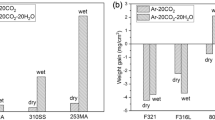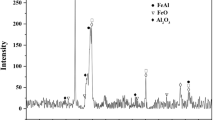Abstract
Although it has been reported that additions of water vapor to high-temperature corrosion environments accelerate corrosion, the role of water vapor on increasing the corrosion rate of Fe–Al–Cr alloys and coatings is not very well understood. In order to better understand these effects, multiple Fe–Al–Cr base alloys were tested at 500°C for 100 hr in three different multi-component corrosive gases with and without water vapor. The three gases were a sulfidizing gas, a mixed oxidizing/sulfidizing gas, and an oxidizing gas. Thermogravimetric testing showed that the corrosion kinetics increased when water vapor up to 6% was added to the atmospheres. The surfaces of the exposed samples were considered carefully to determine if the addition of water vapor changed the morphology of the corrosion products and, more importantly, affected the passive layer. It has previously been shown that the formation of nodules can be caused by the inability of the passive layer to re-heal itself after the presence of a defect allowing fast growing non-protective corrosion products to externally grow from the surface. In this study, the amount of external nodules that formed on the surface of the alloys was shown to increase with the addition of water vapor. An increase in the amount of external nodules present due to additions of water vapor gives an indication that water vapor accelerates the passive-layer breakdown. It was observed that the scale morphology correlated well with the corrosion kinetics for the exposed alloys, which showed that water vapor increased the corrosion rates of the alloys.
Similar content being viewed by others
References
W. E. Boggs, J. Electrochem. Soc. 118, 906-913 (1971).
H. Asteman, J. E. Svensson, L. G. Johansson, and M. Norell, Oxid. Met. 52, 95-111 (1999).
S. Jianian, Z. Longjiang, and L. Tiefan, Oxid. Met. 48, 347-356 (1997).
H. Buscail, and S. Heinze, Oxid. Met. 47, 445-464 (1997).
M. W. Roberts, and P. R. Wood, J. Electron Spectrosc. Relat. Phenom. 11, 431-437 (1977).
G. Hultquist, L. Graasjoe, and Q. Lu, Corros. Sci. 34, 1035-1038 (1993).
J. R. Regina, J. N. DuPont, and A. R. Marder, Submitted for Publication—Mat. Sci. and Eng. A (2003).
J. H. DeVan, and P. F. Tortorelli, Corros. Sci. 35, 1065-1071 (1993).
P. F. Tortorelli, and K. Natesan, Mater. Sci. Eng. A A258, 115-125 (1998).
S. W. Banovic, J. N. DuPont, and A. R. Marder, Scr. Mater. 38, 1763-1767 (1998).
C. G. McKamey, J. H. DeVan, P. F. Tortorelli, and V. K. Sikka, J. Mater. Res. 6, 1779-1805 (1991).
J. R. Regina, J. N. DuPont, and A. R. Marder, Submitted for Publication—Mat. Sci. and Eng. A (2003).
S. W. Banovic, J. N. DuPont, and A. R. Marder, Metall. Maters Trans. A 31A, 1805-1817 (2000).
P. Tomaszewicz, and G. R. Wallwork, Rev. High-Temp. Mater. 4, 75-105 (1978).
R. Prescott, and M. J. Graham, Oxid. Met. 38, 233-254 (1992).
S. W. Banovic, J. N. DuPont, and A. R. Marder, Oxid. Met. 54, 339-369 (2000).
P. F. Tortorelli, G. M. Goodwin, M. Howell, and J. H. DeVan, Proc. Int. Conf. Heat-Resistance Materials II, K. Natesan, G. Krishnamurti, and G. Y. Lai, eds. (1995), 585-590.
HSC Chemistry for Windows, Version 4.0 (1997). Oy, Finland; Outokupmu Research.
Author information
Authors and Affiliations
Rights and permissions
About this article
Cite this article
Regina, J.R., DuPont, J.N. & Marder, A.R. The Effect of Water Vapor on Passive-Layer Stability and Corrosion Behavior of Fe–Al–Cr Base Alloys. Oxidation of Metals 61, 69–90 (2004). https://doi.org/10.1023/B:OXID.0000016277.86061.25
Issue Date:
DOI: https://doi.org/10.1023/B:OXID.0000016277.86061.25




